
The Aeronautica Nazionale Repubblicana (ANR) was the airforce deployed by the Repubblica Sociale Italiana (RSI). Although the ANR was organised by the RSI, much of its operational control came from the Luftwaffe. At first, the ANR fighter units (I° Gruppo Caccia and II° Gruppo Caccia) used Macchi C.205s and Fiat G.55s respectively. Notwithstanding the G.55s gave a good account of themselves against Allied fighters like the Spitfire and Mustang the Luftwaffe’s Jagdfliegerführer (Fighter Controller or Jafü), considering that many of the unit’s pilots had experience flying the Bf 109Gs of the Regia Aeronautica over Sicily, directed that the Fiat G.55s of II°Gr.C would be replaced by Bf 109Gs. Ex-JG 4 Bf 109 G-6 aircraft started arriving at Cascina Vaga on 29 May, and two G-12 trainers were delivered two weeks later. By 22 June, the unit was ready for its first operations.
The unit’s first operation with the Bf 109 occurred on 22 June 1944; eleven Bf 109s sortied from the airfield, although nothing was achieved.
I°Gr.C continued to use a combination of Macchi 205s and Fiat G.55s although, for various reasons, the unit rarely operated from August 1944 through to December, when the first Bf 109 G-12 trainer arrived. Still in December, the remaining 17 pilots of I° Gruppo were moved to Rangsdorf, in Berlin, to start a training course on Me 163 rocket fighter. In November 1944, I°Gr.C was transferred to the Luftwaffe flying school at Holzkirchen in Germany to convert to the Messerschmitts. At the beginning of February, 57 of I° Gruppo’s pilots were ready for operations with the Me 109; 51 (52, according to other sources) G-6s, G-10s and K-4s, most of which came directly from Germany, were available at the end of the month. The fighters were placed on the heath between Lonate Pozzolo and Malpensa airfields, and carefully camouflaged to protect them from Allied air raids. The first combat operation occurred on 14 March 1945. I° Gruppo attempted to intercept B-25 Mitchells of the 321st Bomb Group near Lake Garda but, in turn, were bounced by P-47 Thunderbolts of the 350th Fighter Group. 1° Gruppo had three pilots dead, one wounded, three aircraft lost and six damaged; in return one P-47 was claimed by the Commander Adriano Visconti.
The other ANR fighter unit, II° Gruppo, that had given at the end of May 1944 its G.55s to I° Gruppo, had been re-equipped with 46 ex I./JG 53 and II./JG 77 Bf 109 G-6. On 22 June 1944, it took off on its first operational flight with its Messerschmitts and three days later it shot down two P-47s from the Gaullist French G.C.II/3. At this stage, Luftwaffe ordered ANR pilots to operate outside Italian borders. For instance, on 25 July, 18 Bf 109Gs fron 2° Gruppo were ordered to move to Tulln, in Austria. Here they were subordinated to JG 53. They operated together with German pilots against an Allied bomber raid. During this combined mission eight B-24 Liberators were shot down.
On 2 April 1945, II° Gruppo 29 Bf 109s, from Aviano and Osoppo bases, intercepted a large formation of B-25s over Ghedi, Brescia, escorted by P-47Ds of 347 Fighter Squadron. In the air battle that ensued, ANR pilots suffered a heavy defeat: 14 Bf 109s were shot down and six Italian pilots killed, without scoring a single air victory. On 10 April, three Bf 109s, flown by Sottotenente (Flying Officer) Umberto Gallori, Maresciallo (Warrant Officer) Mario Veronesi and Maresciallo Dino Forlani, intercepted P-47s from 57° Fighter Squadron over Milan and Como. Forlani claimed a P-47 damaged, but the other two Italian fighters were hit and lightly damaged. On 19 April, 1° Gruppo “Asso di bastoni” had its last combat, last claim and its last loss.